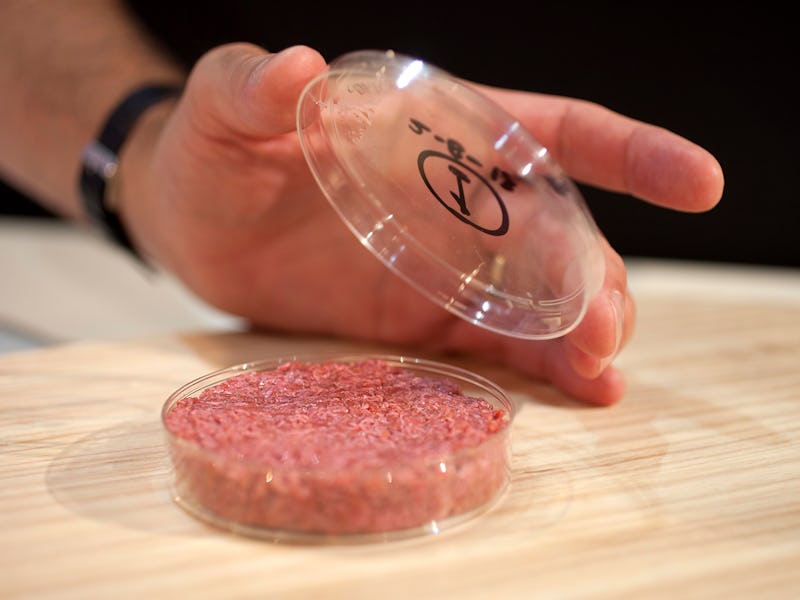Move Over, Impossible Burger: Lab-Grown Meat Will Overtake Plants by 2040
But a lack of innovation could still stifle growth.

Cultured meat could overtake plant-based alternatives like Beyond Meat and Impossible Burger as early as 2040, according to a new report.
The research, from consultancy firm AT Kearney, finds that meat grown in a lab from cells will ultimately become more popular than vegetarian food that replicates the taste of animal products. By then, most of the world’s burgers will be entirely meat-free.
Lab-grown meat is basically non-existent at this stage, as far as most consumers are concerned. The technology involves taking a small sample of animal cells, placing it in a nutrient-rich environment to encourage further growth, and using that to produce meat. Lab grown burgers have been grown before, but the industry thinks that this technique can eventually be used to develop all kinds of meat and animal-product substitutes.
“Worthwhile to note is that new biotechnology methods will disrupt not only the meat industry but the complete food industry as products such as milk, egg white, gelatin, and fish can be created with similar technology,” the report states.
The analysts' projection of global meat consumption over time.
Lab-Grown Meat: How It Could Beat Beyond Meat and Others
Regardless of your moral objections or non-objections to eating meat, the industry itself will have to be either phased out or innovate heavily due to its incredible environmental impact. A 2018 report from the GFI found that eating lab-grown meat alone could reduce greenhouse gas emissions by 74 to 87 percent versus traditional beef. Around eight percent of the United States’ total greenhouse gas emissions comes from agriculture. Meat is a massive source of emissions, and the race to replace is on.
While lab-grown meat stays in the lab, others have taken up the mantle to find a more sustainable solution. Beyond Meat launched in 2009, and Impossible Foods launched two years later. Both firms are focused on using existing plant-based resources to produce food, with innovations to help it better suit more carnivore-esque palates. Impossible Foods, for example, uses heme normally found in hemoglobin (and here sourced from soybeans) to recreate a blood-like taste.
The Impossible Whopper is being rolled out in select locations near St. Louis.
The results so far have been impressive. Burger King’s Impossible Whopper, which debuted in April, has been described as surprisingly close to the real thing. Beyond Meat announced this week that it was working on an even more meat-like veggie burger that produces a “marbling” effect to simulates fat, and uses apple extracts to simulate the shift from red to brown as the food cooks.
But while these products are real and available, AT Kearney believes lab-grown meat will ultimately win the day.
Meat consumption's shift over the coming years.
The report claims that, over the next 15 years, the market will shift toward lab-grown meat as alternatives struggle to maintain their momentum from early innovation. Consumer preferences will also drive a shift to the lab-based approach, as the researchers argue that the similarity to meat drives commercial potential and that, ultimately, lab-grown meat will still taste and feel much more like the real thing.
Lab-brown meat will take a long time to achieve supremacy. In 2013, Mark Post became the first person to eat a lab-grown beef burger, when he ate one made from 20,000 strips of muscle cell. The price at that time was $325,000. But the price since then has fallen rapidly, within just two years, it had dropped to $8.15.
These products will drive down meat consumption even as the whole industry expands, but scientists are unsure whether this will be good for climate change. University of Oxford research found that, while methane-producing cows are lambasted as a major source of greenhouse gases, the methane they produce only stays in the atmosphere for around 12 years. Carbon dioxide, which a lab would in theory produce in spades to power the production of cultured meat, can last for thousands of years.
However, this week’s report pushes back on this notion, and finds that meat alternatives are far more resource-efficient than conventional meat. When taken as a grain-to-meat ratio, animals only operate at around 15 percent efficiency. Cultured meat only needs around 1.5 kg of crops like soy, pease and maize to produce 1 kg of beef, resulting in a 70 percent conversion rate. Plant-based products need around 1.3 kg per kilo of “meat,” resulting in a 75 percent conversion rate.
While bioreactors producing meat may take up a lot of resources now, that could soon change. Industry experts predict that, when built up to mass scale, these systems could use just one-fifth of their current energy consumption during the production process.
While it’s almost impossible to predict food trends two years from now, the evidence suggests that meat will fall out of fashion 20 years from now.